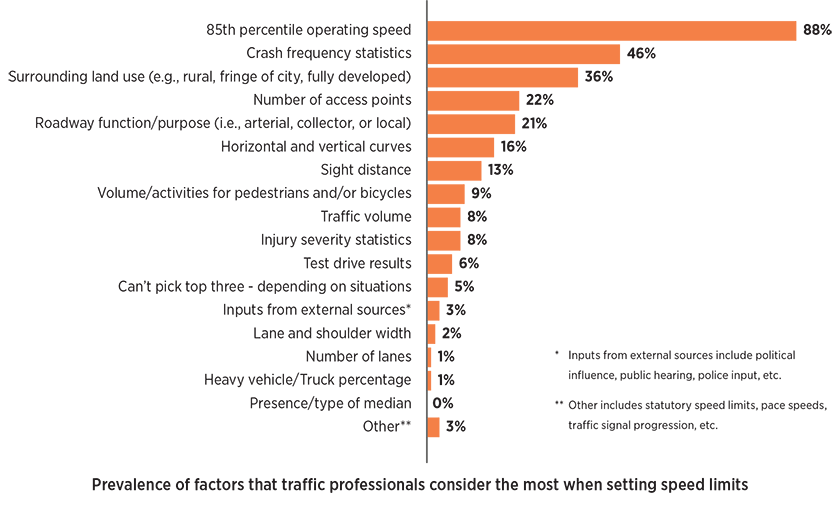
Review of Current Practices for Setting Posted Speed Limits
The aim of this study is to investigate the current practice of how speed limits are set across the country and to understand how the process impacts the traffic environment and drivers’ behaviors.
April 2019
Suggested Citation
For media inquiries, contact:
Tamra Johnson
202-942-2079
TRJohnson@national.aaa.com
Introduction
In 1995, U.S. legislation repealed the 55 mph national maximum speed limit (NMSL) on interstate highways, providing complete freedom for states to set their own speed limits. Since then, states have steadily adjusted their posted speed limits for reasons including modifications in roadway infrastructure, improvements in vehicle and roadway system technologies, and growth in motor vehicles and/or non-motorists’ activities.
A number of studies (Sayed and Sacchi, 2016; Vadeby and Forsman, 2018) have reported that speed limit changes can affect traffic safety, either negatively or positively, depending on how appropriate the new speed limit is for the road, how it is implemented and how the impact of the change is analyzed.
It is important to study how a posted speed limit is set to better understand the traffic environment and drivers’ behaviors, and how the impact of a speed limit change is analyzed when evaluating the effectiveness of that change. As a first step, this study aimed to investigate the current practice of setting a speed limit across the nation through reviewing relevant documentation. Additionally, traffic professionals were surveyed online to obtain direct feedback on how current practices and approaches are implemented in their states.
This research brief presents various approaches for setting posted speed limits identified in the literature as well as the summary of the survey results. A discussion about the challenges of current practices and future directions for speed limit posting is presented, as is a description of the anticipated future work of the AAA Foundation for Traffic Safety.
Key Findings
From the literature review:
- In general, there are five approaches to setting speed limits (Forbes, 2012): 1) statutory speed limits 2) engineering study 3) expert system 4) injury minimization or Safe System approach 5) optimum speed limits.
From the online survey:
- 98% of survey respondents consider the 85th percentile operating speed when raising or lowering posted speed limits.
- 57% of respondents reported their agencies have a standard operating procedure/policy for setting speed limits.
- 30% of respondents either had never heard about an expert system (i.e., USLIMITS or USLIMITS2) or had any understanding of the system.
- Nearly half of the respondents (49%) who had heard about the expert system reported that they never base a decision about changing a speed limit on it.
- The top reason for raising a speed limit is a change or changes in infrastructure, network, land use or road function (63%).
- The top reason to lower a speed is receiving requests from the public to improve safety (76%).
Methodology
This study investigated the current practice of setting a speed limit across the nation through reviewing relevant documentation. Additionally, traffic professionals were surveyed online to obtain direct feedback on how current practices and approaches are implemented in their states and local jurisdictions. The survey included 17 questions (available in Appendix A) about topics including what factors they consider, how they work with those factors to make a decision and how often they implement speed management measures in conjunction with speed limit changes. The survey was administered in the summer of 2018. One hundred and seventy-five traffic engineers across the 48 continental United States participated representing local (44%) and state (54%) agencies, as well as private consulting firms (2%). This brief summarizes some survey results produced from descriptive analyses.
Results
In general, there are five approaches to setting speed limits (Forbes, 2012): 1) statutory speed limits, 2) engineering study, 3) expert system, 4) injury minimization or Safe System approach and 5) optimum speed limits. The uses of these approaches are thought to range fairly significantly, with the engineering study and expert system being most widely used and injury minimization least used in the United States.
However, as found through the literature review and survey of traffic professionals, many jurisdictions in the United States determine a speed limit based on their own practices, engineering studies and/or law requirements that often rely highly on the 85th percentile operating speed.
A significant number of practitioners are well aware of the concern about using the 85th percentile operating speed as a primary factor for determining a speed limit. These respondents agreed that speed limits should be derived from the roadway context (functions, types and land use) in conjunction with other considerations of various factors and community needs. However, they note that law requirements relying on the 85th percentile speed hinder their decision-making processes in setting a speed limit according to rigorous investigations that consider various factors.
Suggested Citation
For media inquiries, contact:
Tamra Johnson
202-942-2079
TRJohnson@national.aaa.com

